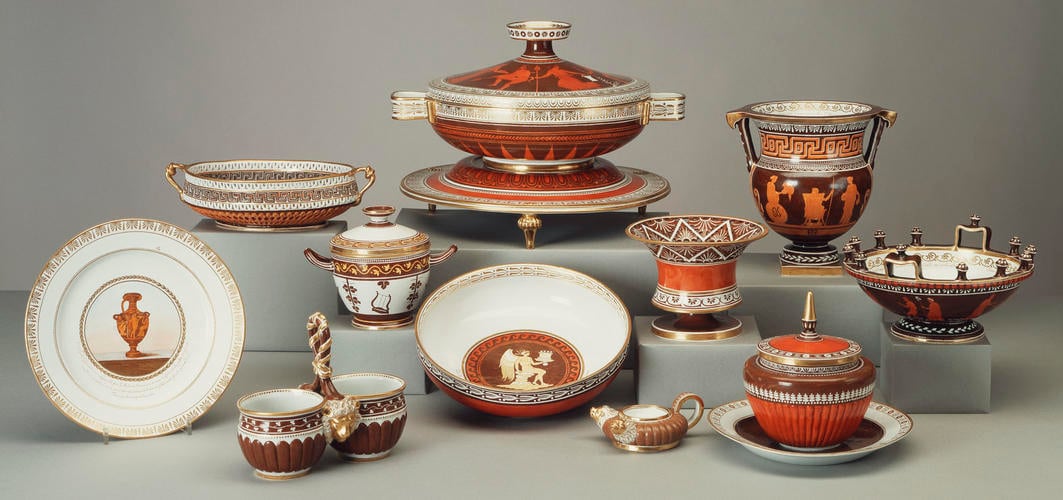-
1 of 253523 objects
A dinner and dessert service, known as the Etruscan Service 1785-87
Soft paste porcelain | RCIN 5000032
-
A soft paste porcelain dinner and dessert service, decorated in neo-classical palette with images and shapes derived from archeological excavations
The neo-classical style shapes of this service is derived from archeological excavations at Nola, Herculaneum, Pompei and in other parts of the then-Kingdom of Naples. It was the most ambitious service produced at the Royal Porcelain Factory which had been established in Naples by the Bourbon King, Ferdinand IV in 1771. The Director of the factory, Domienico Venuti (1745-1817), was also keeper of Antiquities and the service was intended to show off the collection of ancient vases in the Museo Borbonico.
The service now comprises:
105 plates, 27 soup dishes, 4 vegetables dishes and covers, 3 large soup tureens, covers and stands, 4 salad bowls, 3 circular serving dishes, 2 circular serving dishes, 4 salts, 4 cruet stands, 4 fruit baskets, 3 fruit dishes, 3 fruit dishes, 4 ice cream coolers, 2 sugar basins and covers, 4 powdered sugar basins, 2 cups and saucers, 3 bowls, 3 bowls and covers, 3 covers for dishes, 3 bowls, 4 krater shape bottle coolers, 4 wine glass coolers
Measurements: Plates 3.4 x 25.3, soup dishes 7.4 x 25.4 x 22.4, vegetables dishes and covers 20.1 x 34.5 x 26.3, large soup tureens, covers and stands 26.5 x 40.0 x 36.6, salad bowls 8.5 x 26.7, serving dishes 3.0 x 23.7, circular serving dishes 4.6 x 36.8, salts 5.4 x 13.2 x 9.7, cruet stands 17.5 x 20.6 x 10.7, fruit baskets 8.2 x 27.7 x 16.5, fruit dishes 14.3 x 21.8, fruit dishes 12.8 x 18.0, ice cream coolers 38.0 x 23.2, sugar basins and covers 15.0 x 18.6 x 13.0, powdered sugar basins 11.1 x 24.0 x 24.0, cups 4.7 x 8.1, 3 bowls 6.2 x 22.2, bowls and covers 12.0 x 19.0, covers for dishes 7.0 x 18.3, bowls 5.0 x 17.3, krater shape bottle coolers 21.8 x 22.7 x 18.4, wine glass coolers 12.3 x 24.4 x 23.0 cmProvenance
A dinner and dessert service commissioned by Ferdinand IV, King of Naples 1783, by whom presented to George III in 1787. Some contemporary sources suggest it was intended for Queen Charlotte. This was reiterated in the diary of the courtier Madame d'Arblay and its arrival was also noted by Fanny Burney. Shortly after presentation it was sent to Windsor Castle where it was possible to view the service upon entry to the Castle. It may have remained on display for some time; on 23 August 1794 James Painter and Son were paid for 'Removing all ye Neapolitan Chinae, & Cases, into A different Apartment in ye Castle' (RA, Georgian Addl.17/72, Accession 342, MS p.72).
Originally consisting of 282 pieces, of which over 200 survive.
Originally presented with a biscuit porcelain centrepiece apparently representing Tarchon, King of the Etruscans, which was unrecorded in the collection by the late nineteenth century.
The service was transported in the Neopolitan warships Ceres and Minerva under the commander, Cavaliere Fortiguerri. It was hoped that the gift might ease access to British naval shipbuilding information; in 1779 the reorganisation of the Neopolitan navy had been entrusted to John Francis Edward Acton, later Prime Minister of Naples. -
Creator(s)
(porcelain manufacturer)Acquirer(s)
-
Medium and techniques
Soft paste porcelain
Category
Place of Production
Naples [Campania]
